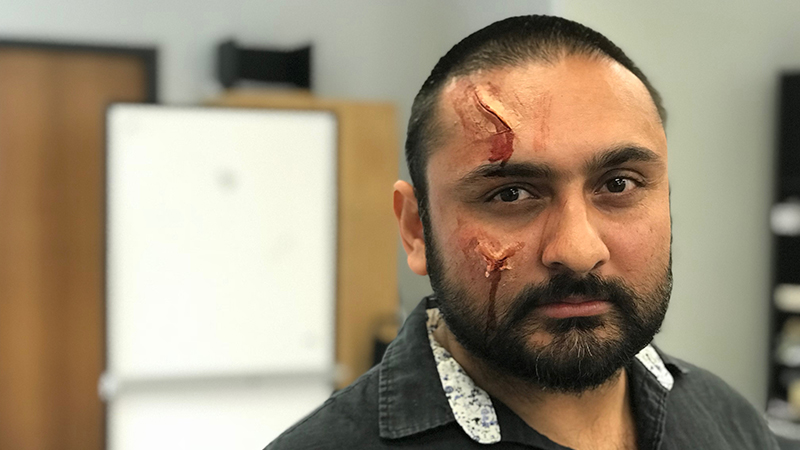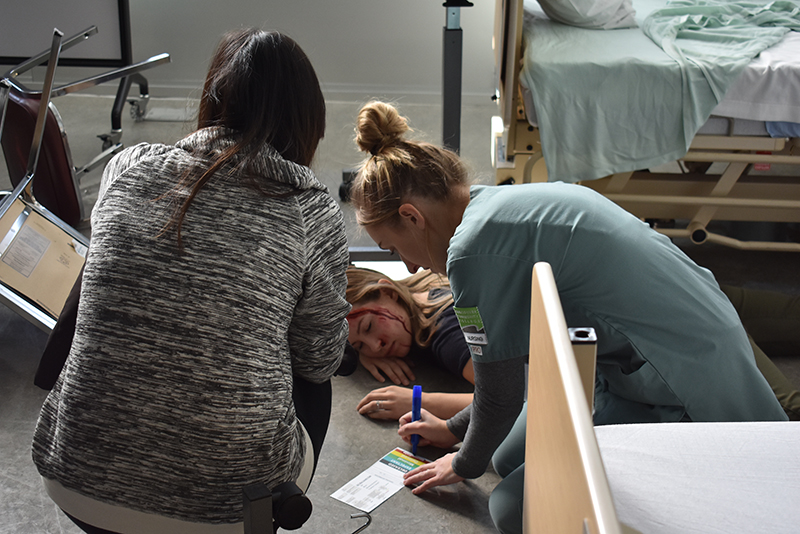Archive News 2020
Disaster simulation during ShakeOut teaches students life-saving skills

For 275 health sciences students at Vancouver Community College (VCC), the Great ShakeOut earthquake drill on Thursday, Oct. 18 involved more than the usual "drop, cover and hold on."
Following the drill, which also tested the college's emergency notification system, students from eight areas including nursing, medical lab assistant, occupational health assistant, dental hygiene and dental technology re-entered select areas of the Broadway campus which had been staged to look as though a disaster had occurred.
This was VCC's third annual college-wide disaster triage training, which involved about 45 "casualties" displaying life-like wounds and injuries and scattered across the third and fourth floors of health sciences Building B.
The realistic-looking injuries, or moulage, were provided by VCC's makeup artistry instructors, who started at 7:30 a.m. making wounds, burns, and blood as believable as possible.
Some actors had lacerations or shards of glass protruding from their bodies. Others lay unconscious or acted disoriented or distraught. All of this happened in dark rooms and hallways where power was cut and furniture strewn across the floor. Chaotic audio effects added to the overall atmosphere.
Bachelor of Science in Nursing student Martina Gueorguiva, who did the simulation for a second year running, says that for many of the students, the experience was eye-opening.
“It makes you realize you won’t always have the supplies or resources in the moment,” she says. “Here, the focus was to work together to sort, assess what’s going on, and see who needs help first and who can be delayed.”

Linda Glatts, Bachelor of Science in Nursing instructor and one of the coordinators of the disaster simulation, says these scenarios are meant to teach the importance of teamwork in a crisis situation and how to collaborate among various health care professionals.
“It stimulates thinking,” says Glatts. “What’s even more valuable is debriefing immediately after the exercise."
In debriefing rooms, facilitators and health care students reunited with their "casualties" and discussed together how a scene was handled. "Feelings, action, and thinking are explored to add to the whole learning experience,” says Glatts.
“A lot of it is about building interpersonal relationships,” she adds. “Having that presence and reassuring casualties that ‘I’m here with you’ is what we hope they can get out of this experience.”
The sight of a disaster-stricken campus had an impact not only on the simulation participants, but also the greater VCC student body who had completed the Great ShakeOut earthquake drill only minutes before.
“I walked in and it looked so real it almost scared me,” said one student passing by. “I think I need to go get my earthquake kit together at home.”
See more photos of VCC's ShakeOut BC disaster simulation.
________________________________________
Do you see yourself working in the health care sector? Learn more about VCC's Pre-Health Sciences program and find out if careers like nursing, pharmacy technician, or medical lab assistant are right for you.
